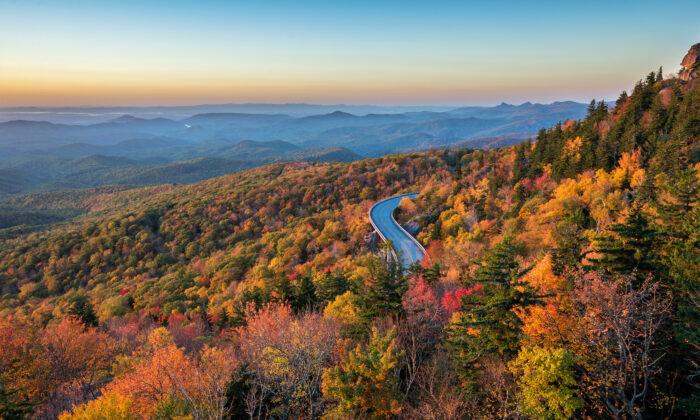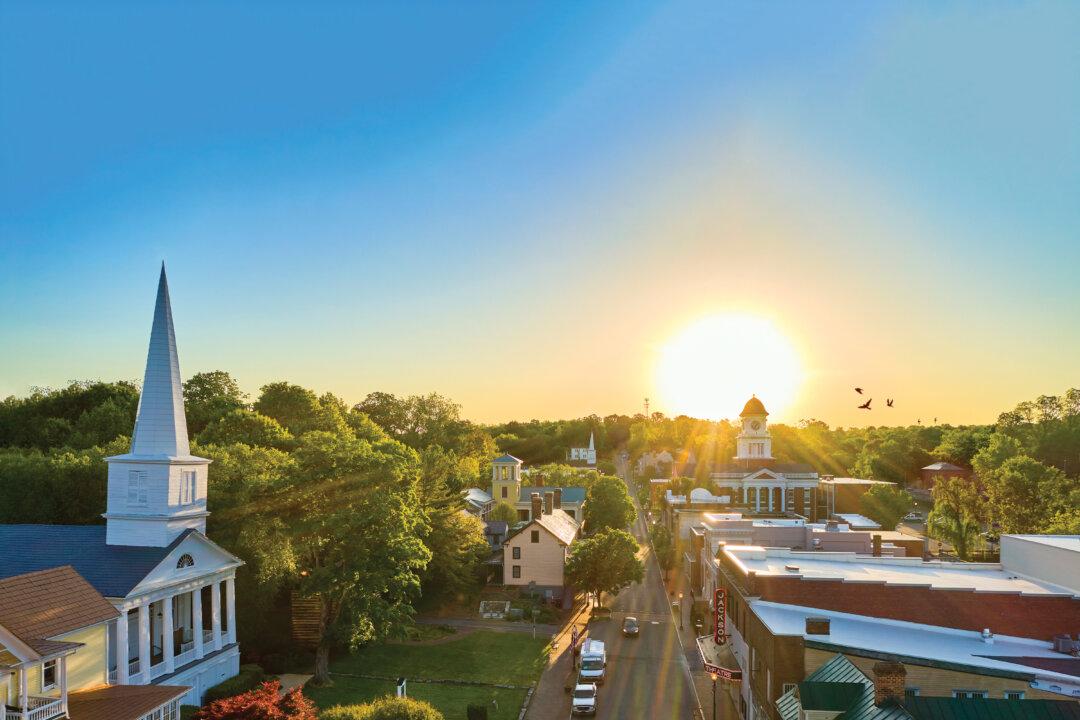The last light is just fading, the final rays casting a purplish hue against the line of mountains ahead—undulating ridges stacked up, over and over again, across the horizon—the cobalt above fading to charcoal, and soon all will be onyx.
It’s been a long day on the road, winding around curves, descending into big, broad valleys, and then back up again, coves calling to hollows (or, if you will, hollers). Behind are hundreds of miles of the South, and rich, fall colors, and ahead, twinkling lights, the promise of a warm bed. It’s the kind of beauty that sneaks up on you. Not the sharp, jutting, stretch-for-the-sky summits of the Alps, or hulk and heft of the snow-capped Rockies; the Blue Ridge is all soft edges and small towns and landscapes from a Thomas Wolfe dust jacket, telling you that you can’t go home again—at least not yet.
And, forming America’s longest linear park, the Blue Ridge Parkway (BRP) runs through the heart of it, running for 469 miles, connecting Shenandoah National Park in Virginia with Great Smoky Mountains National Park, which straddles the North Carolina/Tennessee border.
Construction began in the 1930s and took more than a half-century to complete, the last section opening just in 1987. This two-lane adventure, sometimes known as “America’s favorite drive,” is one that’s best taken at a slow pace (the speed limit never rises higher than 45 miles per hour, and big trucks aren’t allowed on the road), and enjoyed over several days. This guide will take you through its highlights and stops along the way.
Skyline Drive
Although technically not part of the Parkway, it’s worth starting your journey on the 105-mile Skyline Drive, which rides the spine of the mountains in rather spectacular fashion through Shenandoah National Park, and then connects directly onto the BRP.Ascend from Front Royal, Virginia; switchbacks take you to a sort of elongated summit, the ridge falling away on both sides. Regular roadside pull-offs (75 of them, in all) showcase vistas over the serpentine Shenandoah River to the west, and a vast patchwork of Virginia countryside to the east.
Built during the Great Depression by the Civilian Conservation Corps, stops along the way, including Skyland Resort and the visitors’ center at Big Meadows, have that vintage stone-and-timber feel. Take a little extra time for a hike to a waterfall, like the 1.4-mile loop to Dark Hollows Falls.
James River Visitors Center (Milepost 63.6)
George Washington himself advocated for the James River and Kanawha Canal, a grand project intended to connect then-remote western Virginia with the Atlantic coast through the James River Gorge. Construction began in 1785 but was never completed, with floods and financial hardship foiling its progress, and railroads finally overtaking boat travel in ease and importance (the route became a thoroughfare for trains and, later, automobiles).Stop here to stretch your legs along a series of reconstructed locks, hike some short trails, and learn more about the project at the exhibits inside the visitor center, which is operated by the National Park Service.
Peaks of Otter (Mileposts 84 to 87)
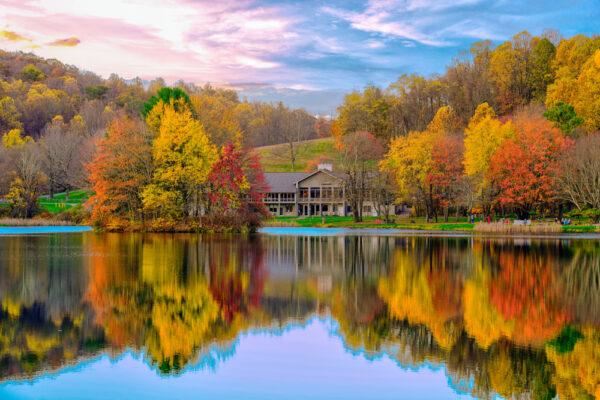
Peaks of Otter Lodge. Hane Street/Shutterstock
A perfect place to pause your travels for the night, the Peaks of Otter is a tourist village that includes a restaurant and lodge that both overlook a lovely lake, which is backed by those namesake peaks. The area also offers lots of hiking—those feeling energetic can lace up their boots and make the ascent to nearby Sharp Top (altitude 3,875 feet), but if you’re just looking for a stroll, walk the two-mile loop to Johnson Farm, which recreates pastoral life in the 1930s, complete with, in season, living history demonstrators.
Smart View (Milepost 154.5)
For birders, the forests and woodlands and trails at Smart View Recreational Area are filled with all sorts of winged friends, both during spring and summer migrations, as well as resident species. Look up to spot brown thrashers, red-bellied woodpeckers, great-crested flycatchers, and, a relative rarity, a breeding group of cerulean warblers. There’s lots of other wildlife, too—box turtles, red fox, and white-tailed deer, to name a few.Rocky Knob (Mileposts 167 to 174)
A stop for serious hikers, the Rock Castle Gorge Trail is a strenuous 10.8-mile route with elevations that vary almost 2,000 feet, and plenty of steep, rocky sections. But those who try it will be rewarded, as the trail is lined with mountain laurel and passes old home sites, as well as waterfalls.Mabry Mill (Milepost 176)
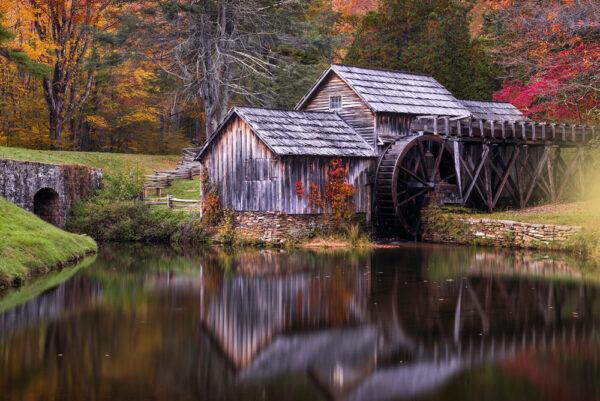
Autumn colors at Mabry Mill along the Blue Ridge Parkway in Virginia. anthony heflin/Shutterstock
Stop by a picturesque creekside sawmill and blacksmith shop that dates back to 1905, to take a walk through history, with costumed demonstrators showing off blacksmithing, basket-making, and spinning skills. And maybe tarry for a while for some home-cooked fare at the on-site restaurant.
At Milepost 216.9, you will cross the Virginia/North Carolina border. The section of the Parkway just ahead—the final 250 miles—is its highest and most spectacular, intersecting with other ranges, including the dramatic Black Mountains.
Moses H. Cone Memorial Park (Milepost 292.7)
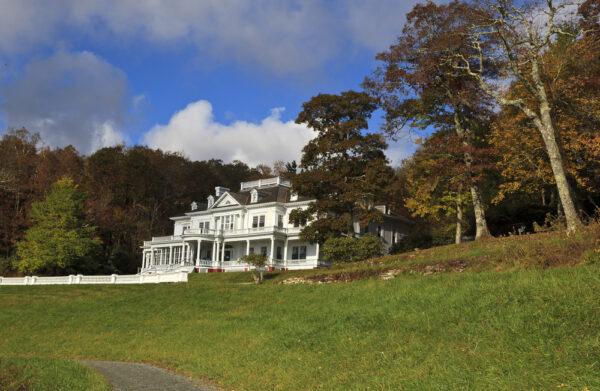
Moses H. Cone Flat Top Manor. Jill Lang/Shutterstock
It’s home to Flat Top Manor, the white, rambling Colonial Revival mansion built in the 1890s by a textile baron named Moses Cone. The 23-room home, built as a country retreat for Cone and his wife, Bertha, is worth the stop, as are the well-tended grounds, which include 25 miles of carriage paths (excellent for biking in the summer, and cross-country skiing in the winter) as well as two man-made lakes. Plus, see the creation of handicrafts at the on-site Parkway Craft Center.
Linn Cove Viaduct (Milepost 304)
One of the most photographed curves in the road, this was the last section of the Parkway to be completed, a seven-mile engineering marvel that clings to the face of Grandfather Mountain. Stop at the visitor center to see how they did it.Grandfather Mountain (Milepost 305.1)
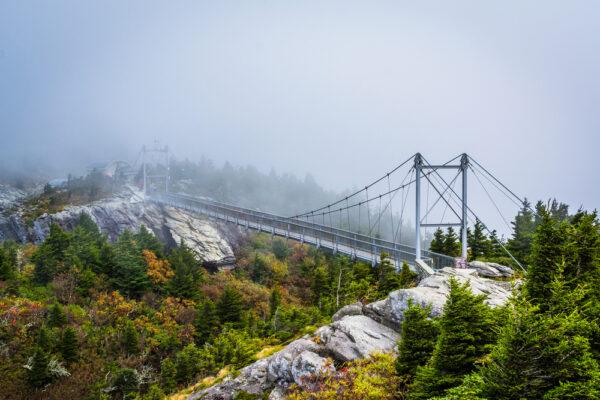
The Mile High Swinging Bridge at Grandfather Mountain. Jon Bilous/Shutterstock
It’s the tallest peak in the Blue Ridge (its summit reaches almost 6,000 feet). Drive a few miles off the BRP to walk across the Mile High Swinging Bridge, which connects two peaks, one mile above sea level. It’s a private park, which also has a petting zoo and other attractions, and there’s a fee to enter. And make sure to snap a shot at Flat Rock, just a few miles further down the road at Milepost 308.3.
Mt. Mitchell State Park (Milepost 355.4)
You can drive almost to the 6,684-foot top of Mount Mitchell, the highest point east of the Mississippi River. At its namesake state park, you can visit the on-site museum to learn about the mountain’s history, or take a hike on their network of trails. But you might just be tempted to just sit on a bench and enjoy the views from the summit, which seem to stretch on forever.Craggy Gardens (Mileposts 364.4 to 367.6)
A unique and beautiful display of high-altitude flowers (especially in late spring and summer, but worth a stop any time of year), take a few minutes at the visitor center (at 364.4), then drive into the gardens, which burst with purple Catawba rhododendrons and other colorful blooms.Blue Ridge Parkway Visitor Center (Milepost 384)
Located in a LEED-certified building, this, the newest and most impressive of visitor centers along the route includes a number of high-tech exhibits, including a 22-foot interactive “I-Wall” and a high-definition film about one family journey down the Parkway. Noteworthy: the town of Asheville is nearby, and worth a stop to explore its musical and culinary attractions, as well as Biltmore Estate.At Milepost 431, you'll drive over the highest point on the Parkway (at 6,047 feet), where you can stop and take a short, celebratory nature walk through a spruce-fir forest.
And at Milepost 469.1, the Blue Ridge Parkway—and your journey—reaches its conclusion. Fortunately, you’re already inside Great Smoky Mountains National Park, a place full of waterfalls, ridgeline hikes, and other amazing ways to extend your adventures.
Toronto-based writer Tim Johnson is always traveling in search of the next great story. Having visited 140 countries across all seven continents, he’s tracked lions on foot in Botswana, dug for dinosaur bones in Mongolia, and walked among a half-million penguins on South Georgia Island. He contributes to some of North America’s largest publications, including CNN Travel, Bloomberg, and The Globe and Mail.

